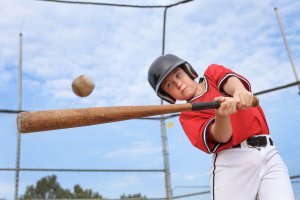The Benefits of Physical Exercise for Children

The benefits of physical exercise for children were established a long time ago. And any physical education class in school demonstrates how useful and important it is.
There’s no single sport which is best for children to take part in. It’ll all depend on where you live and what your child enjoys doing. The parents also play an important role as their encouragement will be vital.
Another important influence when it comes to physical exercise for children is the coach. The coach should be a suitable person who can guide children to achieve clear adjectives whilst also avoiding injury.
As a general recommendation, the World Health Organization (WHO) encourages at least one hour of physical exercise for children per day. But of course, if they can do more than this, so much the better.
Four benefits of physical exercise for children
Broadly speaking, there are four areas of cognitive and physical development that benefit from physical exercise during childhood: the heart, muscle strength, coordination, and flexibility.
Heart
If you play sports regularly, the heart muscles adapt in several ways in line with your efforts. Your heart rate gradually decreases and the heart becomes more efficient.

This is a great benefit for growing children. In a similar way, the lungs also adapt to exercise, thereby improving respiratory function.
Muscle strength
Muscle development is an essential part of childhood. Children are so active that they use their muscles constantly throughout the day, and they’ll continue to develop as they grow taller and gain weight. As the years go by, their muscle mass increases.
That muscle mass needs training because muscle weakness in adulthood is a risk factor for a number of conditions. Similarly, elderly people who don’t have enough muscle strength are more likely to suffer falls and fractures. If muscles are strengthened from childhood, there’s more chance of them having good muscle tone and mass in adulthood.
Balance and coordination
Another benefit of physical exercise for children is improved balance and coordination. Both of these develop a lot during childhood and also undergo changes during adolescence.
Physical exercise helps develop proprioception, awareness of the body’s position, and movement in space. Good posture is also essential to avoid back problems, such as kyphosis or scoliosis.
A child with good balance and coordination will fall down less and obviously, hurt themselves less often. This is an often-underestimated factor in their quality of life. For example, many injuries or traumas cause children to miss days of school.
Flexibility
Flexibility is related to muscle tone. If your child lacks flexibility, this will lead to problems in the near and distant future. Adults with less flexibility are more prone to rheumatic diseases.
Flexibility helps to protect the joints. However, it’s not a good idea to overdo training, as some injuries can be quite serious. For example, in artistic gymnastics, the coach’s main role is to ensure that the child doesn’t overdo things or injure themselves.
How much physical exercise should a child do according to their age
The WHO has developed some guidelines regarding the amount of physical exercise for children according to age:
- Children less than one-year-old should be stimulated with interactive play. They suggest 30 minutes of face-down activity per day to develop their posture.
- Between one and two years, they should have at least three hours of physical activity each day. Obviously, anything that involves a screen or keeps them sitting still for long periods of time is strongly discouraged.

- For children over three and under five years old, the number of exercise hours is the same as for the previous age group, but they should be of moderate intensity.
- From the age of five years and upwards, the minimum requirement is one hour of moderate to intense exercise.
Complements to physical exercise for children
The benefits of physical exercise for children can be complemented with a healthy balanced diet and the right amount of rest. Adults should ensure that children, wherever they are in the world, have the chance to play, eat well, and get enough sleep. With all this combined, sport can play an important role in the development of healthy children.
The benefits of physical exercise for children were established a long time ago. And any physical education class in school demonstrates how useful and important it is.
There’s no single sport which is best for children to take part in. It’ll all depend on where you live and what your child enjoys doing. The parents also play an important role as their encouragement will be vital.
Another important influence when it comes to physical exercise for children is the coach. The coach should be a suitable person who can guide children to achieve clear adjectives whilst also avoiding injury.
As a general recommendation, the World Health Organization (WHO) encourages at least one hour of physical exercise for children per day. But of course, if they can do more than this, so much the better.
Four benefits of physical exercise for children
Broadly speaking, there are four areas of cognitive and physical development that benefit from physical exercise during childhood: the heart, muscle strength, coordination, and flexibility.
Heart
If you play sports regularly, the heart muscles adapt in several ways in line with your efforts. Your heart rate gradually decreases and the heart becomes more efficient.

This is a great benefit for growing children. In a similar way, the lungs also adapt to exercise, thereby improving respiratory function.
Muscle strength
Muscle development is an essential part of childhood. Children are so active that they use their muscles constantly throughout the day, and they’ll continue to develop as they grow taller and gain weight. As the years go by, their muscle mass increases.
That muscle mass needs training because muscle weakness in adulthood is a risk factor for a number of conditions. Similarly, elderly people who don’t have enough muscle strength are more likely to suffer falls and fractures. If muscles are strengthened from childhood, there’s more chance of them having good muscle tone and mass in adulthood.
Balance and coordination
Another benefit of physical exercise for children is improved balance and coordination. Both of these develop a lot during childhood and also undergo changes during adolescence.
Physical exercise helps develop proprioception, awareness of the body’s position, and movement in space. Good posture is also essential to avoid back problems, such as kyphosis or scoliosis.
A child with good balance and coordination will fall down less and obviously, hurt themselves less often. This is an often-underestimated factor in their quality of life. For example, many injuries or traumas cause children to miss days of school.
Flexibility
Flexibility is related to muscle tone. If your child lacks flexibility, this will lead to problems in the near and distant future. Adults with less flexibility are more prone to rheumatic diseases.
Flexibility helps to protect the joints. However, it’s not a good idea to overdo training, as some injuries can be quite serious. For example, in artistic gymnastics, the coach’s main role is to ensure that the child doesn’t overdo things or injure themselves.
How much physical exercise should a child do according to their age
The WHO has developed some guidelines regarding the amount of physical exercise for children according to age:
- Children less than one-year-old should be stimulated with interactive play. They suggest 30 minutes of face-down activity per day to develop their posture.
- Between one and two years, they should have at least three hours of physical activity each day. Obviously, anything that involves a screen or keeps them sitting still for long periods of time is strongly discouraged.

- For children over three and under five years old, the number of exercise hours is the same as for the previous age group, but they should be of moderate intensity.
- From the age of five years and upwards, the minimum requirement is one hour of moderate to intense exercise.
Complements to physical exercise for children
The benefits of physical exercise for children can be complemented with a healthy balanced diet and the right amount of rest. Adults should ensure that children, wherever they are in the world, have the chance to play, eat well, and get enough sleep. With all this combined, sport can play an important role in the development of healthy children.
All cited sources were thoroughly reviewed by our team to ensure their quality, reliability, currency, and validity. The bibliography of this article was considered reliable and of academic or scientific accuracy.
- Guzmán, P. Hernán. Lesiones deportivas en niños y adolescentes. Revista Médica Clínica Las Condes 23.3 (2012): 267-273.
- Cladellas Pros, Ramon, et al. Patrones de descanso, actividades físico-deportivas extraescolares y rendimiento académico en niños y niñas de primaria. Revista de Psicología del Deporte 24.1 (2015): 0053-59.
- Clemente Garulo, Daniel. Transición en niños y adolescentes con enfermedades reumáticas. Diss. 2018.
- Latorre, P. A., et al. Análisis de la influencia de los padres en la promoción deportiva de los niños. Journal of Sport and Health Research 1.1 (2009): 12-25.
This text is provided for informational purposes only and does not replace consultation with a professional. If in doubt, consult your specialist.








